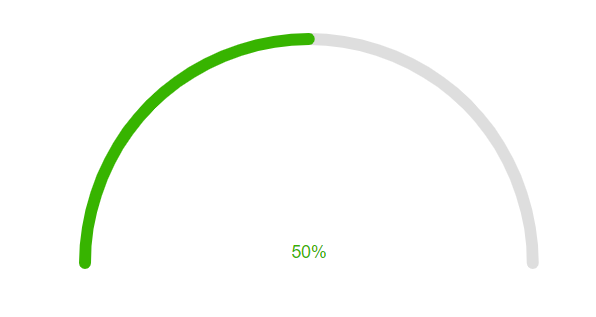Getting Started with the ArcGauge
This tutorial explains how to set up a basic Telerik UI for ASP.NET Core ArcGauge and highlights the major steps in the configuration of the component.
You will initialize an ArcGauge component with different colors depending on the current value. Next, you will use the built-in client-side methods to update the ArcGauge options and change its value dynamically. Finally, you can run the sample code in Telerik REPL and continue exploring the components.

Prerequisites
To successfully complete the tutorial, you need a project that is already configured to use the Telerik UI for ASP.NET Core components:
- To create a new pre-configured project for the Telerik UI for ASP.NET Core components, you can use a project template.
1. Prepare the CSHTML File
The first step is to add the required directives at the top of the .cshtml document:
-
To use the Telerik UI for ASP.NET Core HtmlHelpers:
@using Kendo.Mvc.UI -
To use the Telerik UI for ASP.NET Core TagHelpers:
@addTagHelper *, Kendo.Mvc
Optionally, you can structure the View content by adding the desired HTML elements like headings, divs, paragraphs, and others.
@using Kendo.Mvc.UI
<div id="gauge-container">
</div>
@addTagHelper *, Kendo.Mvc
<div id="gauge-container">
</div>
2. Initialize the ArcGauge
Use the ArcGauge HtmlHelper or TagHelper to add the component to a page:
- The
Name()configuration method is mandatory as its value is used for theidand thenameattributes of the ArcGauge element. - The
Scale()option specifies the ArcGauge scale options, like labels, the lowest and highest value, and more. - The
Value()option sets the initial ArcGauge value. - The
CenterTemplate()specifies the label template displayed in the center of the arc.
@using Kendo.Mvc.UI
<div id="gauge-container">
@(Html.Kendo().ArcGauge()
.Name("gauge")
.Value(50)
.Scale(x => x.Min(0).Max(100))
.CenterTemplate("<span>#: value #%</span>")
)
</div>
@addTagHelper *, Kendo.Mvc
<div id="gauge-container">
<kendo-arcgauge name="gauge"
value="50"
center-template="<span>#: value #%</span>">
<scale min="0" max="100"></scale>
</kendo-arcgauge>
</div>
3. Configure the Color Ranges
The next step is to set up the color ranges of the ArcGauge and update the label template to display the current value in the respective color.
@using Kendo.Mvc.UI
<div id="gauge-container">
@(Html.Kendo().ArcGauge()
.Name("gauge")
.Value(50)
.Scale(x => x.Min(0).Max(100))
.CenterTemplate("<span style='color: #: color #;'>#: value #%</span>")
.Colors(colors =>
{
colors.Add().From(0).To(25).Color("#0058e9");
colors.Add().From(25).To(50).Color("#37b400");
colors.Add().From(50).To(75).Color("#ffc000");
colors.Add().From(75).To(100).Color("#f31700");
})
)
</div>
@addTagHelper *, Kendo.Mvc
<div id="gauge-container">
<kendo-arcgauge name="gauge"
value="50"
center-template="<span style='color: #: color #;'>#: value #%</span>">
<scale min="0" max="100"></scale>
<colors>
<color from="0" to="25" color="#0058e9" />
<color from="25" to="50" color="#37b400" />
<color from="50" to="75" color="#ffc000" />
<color from="75" to="100" color="#f31700" />
</colors>
</kendo-arcgauge>
</div>
4. (Optional) Reference Existing ArcGauge Instances
You can reference the ArcGauge instances that you have created and build on top of their existing configuration:
-
Use the
idattribute of the component instance to get its reference.<script> $(document).ready(function() { var arcGaugeReference = $("#gauge").data("kendoArcGauge"); // arcGaugeReference is a reference to the existing ArcGauge instance of the helper. }); </script> -
Use the ArcGauge client-side API to control the behavior of the component. In this example, you will use the
value()method to change the ArcGauge value and thesetOptions()method to update the background color (for example, when a button is clicked).@(Html.Kendo().Button() .Name("btn") .Content("Update value") .Events(ev => ev.Click("onBtnClick")) )@addTagHelper *, Kendo.Mvc <kendo-button name="btn" on-click="onBtnClick"> Update value </kendo-button><script> function onBtnClick() { var arcGaugeReference = $("#gauge").data("kendoArcGauge"); if(arcGaugeReference.value() < 80) { arcGaugeReference.setOptions({gaugeArea: {background: "#FFD700"}}); arcGaugeReference.value(80); } } </script>
For more information on referencing specific helper instances, see the Methods and Events article.
Explore this Tutorial in REPL
You can continue experimenting with the code sample above by running it in the Telerik REPL server playground: